ESP AUDI TT COUPE 2016 Workshop Manual
[x] Cancel search | Manufacturer: AUDI, Model Year: 2016, Model line: TT COUPE, Model: AUDI TT COUPE 2016Pages: 322, PDF Size: 52.86 MB
Page 191 of 322
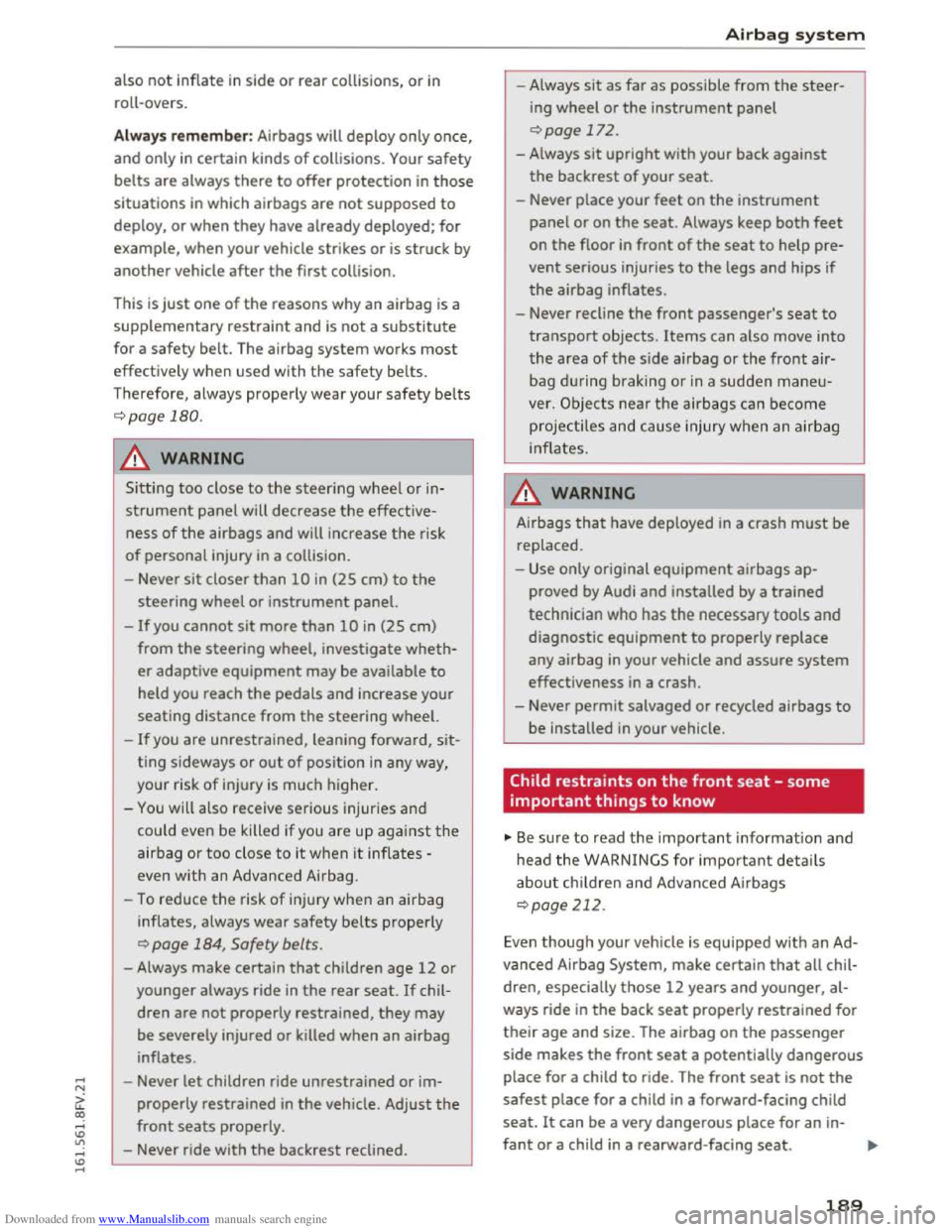
Downloaded from www.Manualslib.com manuals search engine ...... N
G'. CX)
..... ID IJ' ..... ID .....
also not inflate in side or rear collisions, or in
roll-overs.
Always rememb er: Airbags will deploy only once,
and only
in certain kinds of collisions . Your safety
belts are always there to offer protection in those
situations in which airbags are not supposed to
deploy, or when they have already deployed; for
example, when your vehicle strikes or is struck by
another vehicle after the first collision.
This
is just one of the reasons why an airbag is a
supplementary restraint and is not a substitute
for a safety belt. The airbag system works most
effectively when used with the safety belts.
Therefore, always properly wear your safety belts
r:::;.page 180.
A WARNING
-
Sitting too close to the steering wheel or in-
strument panel will decrease the effective
ness of the airbags and will increase the risk
of personal injury in a collision.
- Never
sit closer than 10 in (25 cm) to the
steering wheel or instrument panel.
-
If you cannot sit more than 10 in (25 cm)
from the steering wheel, investigate wheth
er adaptive equipment may be available to
held you reach the pedals and increase your
seating distance from the steering wheel.
-If you are unrestrained, leaning forward, sit
t ing sideways
or out of position in any way,
your risk
of injury is much higher.
-
You will also receive serious injuries and
could even be killed if you are up against the
airbag or too close to it when it inf lates -
even with an Advanced Airbag.
- To reduce
the risk of injury when an airbag
inflates, always
wear safety belts properly
Q page 184, Safety belts.
-Always make certain that children age 12 or
younger always ride in the rear seat. If chil
dren are not properly restrained, they may
be severely injured or killed when an airbag
inflates.
- Never
let children ride unrestrained or im
properly
restrained in the vehicle. Adjust the
front seats properly .
- Never ride with
the backrest reclined .
Airbag system
-Always sit as far as possible from the steer
ing wheel or the instrument panel
r:=:>page 172.
-Always sit upright with your back against
the backrest of your seat.
- Never place your feet on the instrument
panel or on the seat. Always keep both feet
on the floor in front of the seat to help pre
vent serious injuries to the legs and hips if
the airbag inflates.
- Never recline
the front passenger's seat to
transport objects. Items can also move into
the area of the side airbag or the front air
bag during braking
or in a sudden maneu
ver. Objects near the airbags can become
projectiles and cause injury when an airbag
inflates.
A WARNING ___,j
Airbags that have deployed in a crash must be
replaced.
-
Use only original equipment airbags ap
proved by Audi and installed by a trained
technician who has the necessary tools and
diagnostic equipment to properly replace
any
airbag in your vehicle and assure system
effectiveness in a crash.
- Never
permit salvaged or recycled airbags to
be installed in your vehicle.
Child restraints on the front seat -some
important things to know
"' Be sure to read the important information and
head the WARNINGS for important details
about children and Advanced Airbags
r:::;.page 212.
Even though your vehicle is equipped with an Ad
vanced Airbag
System, make certain that all chil
dren, especially those 12 years and younger, al
ways ride
in the back seat properly restrained for
their age and size. The airbag on the passenger
side makes the front seat a potentially dangerous
place for a child to ride . The front seat is not the
safest place for a child in a forward-facing child
seat. It can be a very dangerous place for an in-
fant or a child in a rearward -facing seat. ..,.
189
Page 194 of 322

Downloaded from www.Manualslib.com manuals search engine Airbag system
not, or to signal that it is occupied by some
one who is heavier than the person actually
sitting on the seat. The presence of addi
tional objects could cause the passenger
front airbag to be turned on when it should
be off, or could cause the airbag to work in a
way
that is different from the way it would
have worked
without the object on the seat.
Front airbags
Description of front airbags
The airbag system can provide supplemental
protection to properly restrained front
seat occu
pants.
Fig. 155 Locat ion of driver airbag : in steering wheel
Fig.
156 Location of front passenger's airbag: in the in·
strument panel
Your vehicle is equipped with an "Advance d Air
bag System" in compliance with United States
Federal Motor Vehicle Safety Standard
(FMVSS) 208 as applicable at the time your vehi
cle
was manufactured. The safety belts for the
front seats have "pretensioners" that help to
take slack out of the belt system. The pretension
ers are also activated by the electronic control
unit for the airbag system.
192
The front safety belts also have load limiters to
help reduce the forces applied to the body in a
crash.
The airbag
for the driver is in the steering wheel
hub i::> fig. 155 and the airbag for the front pas
senger is in the instrument panel i::> fig. 156. The
general location of the airbags is marked "AIR
BAG".
There is a lot you need to know about the airbags
in your vehicle. We urge you to read the detailed
information about airbags, safety belts and child
safety in this and the other chapters that make
up the owner's literature. Please be sure to heed
the WARNINGS -they are extremely important
for your safety and the safety of your passengers,
especially infants and small children .
_&WARNING
-
Never rely on airbags alone for protection.
- Even when they deploy, airbags provide only
supplemental protection.
-Airbag work most effectively when used
with properly
worn safety belts.
- Therefore, always
wear your safety belts and
make sure that everybody in your vehicle is
properly
restrained.
- Always hold the steering wheel with both
hands on the outside of the steering wheel
rim at the 9:00 o'clock and 3:00 o'clock po
sitions
to help reduce the risk of personal in
jury if the driver's airbag inflates.
-Never hold the steering wheel at the 12
o'clock position or with your hands any
where inside the steering wheel or on the
steering wheel hub. Holding the steering
wheel the wrong way increases the risk of
severe injury to the arms, hands, and head if
the driver airbag deploys.
_&WARNING
Objects between you and the airbag will in
crease the risk of injury in a crash by interfer
ing with the way the airbag unfolds and/or by
being pushed into you as the airbag inflates.
- Always
make sure nothing is in the front air-
bag deployment zone that could be struck
by the airbag when it inflates. _____ ___.
Page 195 of 322
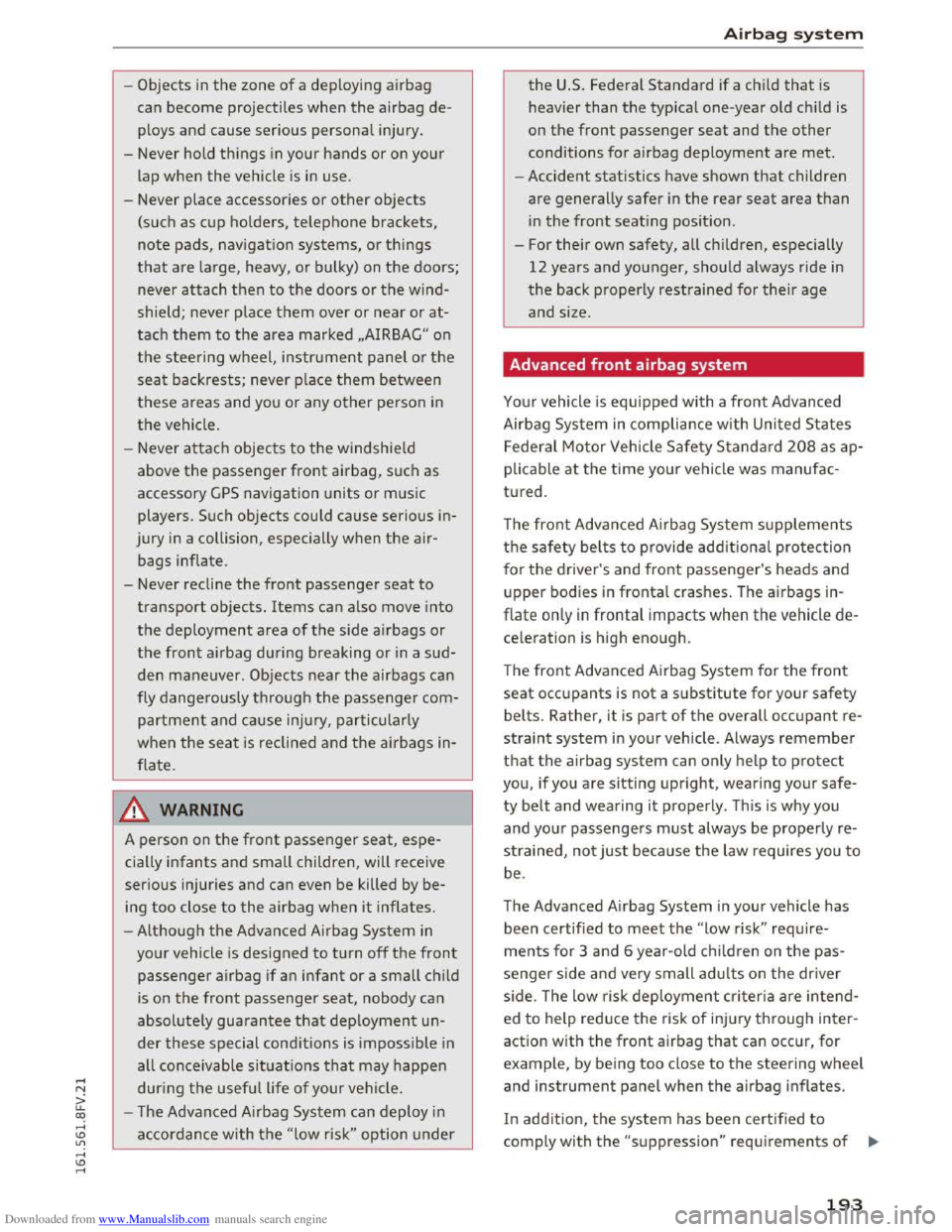
Downloaded from www.Manualslib.com manuals search engine -Objects in the zone of a deploying airbag
can
become projectiles when the airbag de
ploys and cause serious personal injury.
- Never hold
things in your hands or on your
lap
when the vehicle is in use.
-Never place accessories or other objects
(such as cup holders, telephone brackets,
note pads, navigation systems, or things
that are large, heavy, or bulky) on the doors;
never
attach then to the doors or the wind
shield; never place
them over or near or at
tach them to the area marked ,.AIRBAG" on
the steering wheel, instrument panel or the
seat backrests; never place them between
these areas and you or any other person in
the vehicle.
- Never
attach objects to the windshield
above
the passenger front airbag, such as
accessory GPS navigation units or music
players. Such
objects could cause serious in
jury
in a collision, especially when the air
bags inflate.
- Never recline
the front passenger seat to
transport objects. Items can also move into
the deployment area of the side airbags or
the front airbag during breaking or in a sud
den maneuver. Objects near the airbags can
fly dangerously through the passenger com
partment and cause injury, particularly
when the seat is reclined and the airbags in
flate.
A WARNING
A person on the front passenger seat, espe
cially infants and small children, will receive
serious injuries and can even be killed by be
ing
too close to the airbag when it inflates.
- Although
the Advanced Airbag System in
your vehicle is designed to turn off the front
passenger airbag if an infant or a small child
is on
the front passenger seat, nobody can
absolutely guarantee that deployment un
der these special conditions is impossible in
all conceivable situations that may happen
during the useful life of your vehicle.
- The Advanced Airbag
System can deploy in
accordance with the "low risk" option under
-I
Airbag system
the U.S. Federal Standard if a child that is
heavier
than the typical one-year old child is
on
the front passenger seat and the other
conditions for airbag deployment are met.
- Accident statistics have shown that children
are generally safer in the rear seat area than
in the front seating position .
- For
their own safety, all children, especially
12 years and younger, should always ride in
the back properly restrained for their age
and size.
Advanced front airbag system
Your vehicle is equipped with a front Advanced
Airbag
System in compliance with United States
Federal Motor Vehicle Safety Standard 208 asap
plicable at the time your vehicle was manufac
tured.
The front Advanced Airbag System supplements
the safety belts to provide additional protection
for the driver's and front passenger's heads and
upper bodies in frontal crashes. The airbags in
flate only in frontal impacts when the vehicle de
celeration is high enough.
The front Advanced Airbag System for the front
seat occupants is not a substitute for your safety
belts. Rather, it is part of the overall occupant re
straint system in your vehicle. Always remember
that the airbag system can only help to protect
you, if you are sitting upright, wearing your safe
ty belt and wearing it properly. This is why you
and your passengers must always be properly re
strained, not just because the law requires you to
be.
The Advanced Airbag
System in your vehicle has
been certified to meet the "low risk" require-
ments for 3 and 6 year-old children on the pas
senger side and very small adults on the driver
side. The low risk
deployment criteria are intend
ed to help reduce the risk of injury through inter
action with the front airbag that can occur, for
example, by being too close to the steering wheel
and instrument panel when the airbag inflates.
In addition,
the system has been certified to
comply with the "suppression" requirements of .,..
193
Page 197 of 322
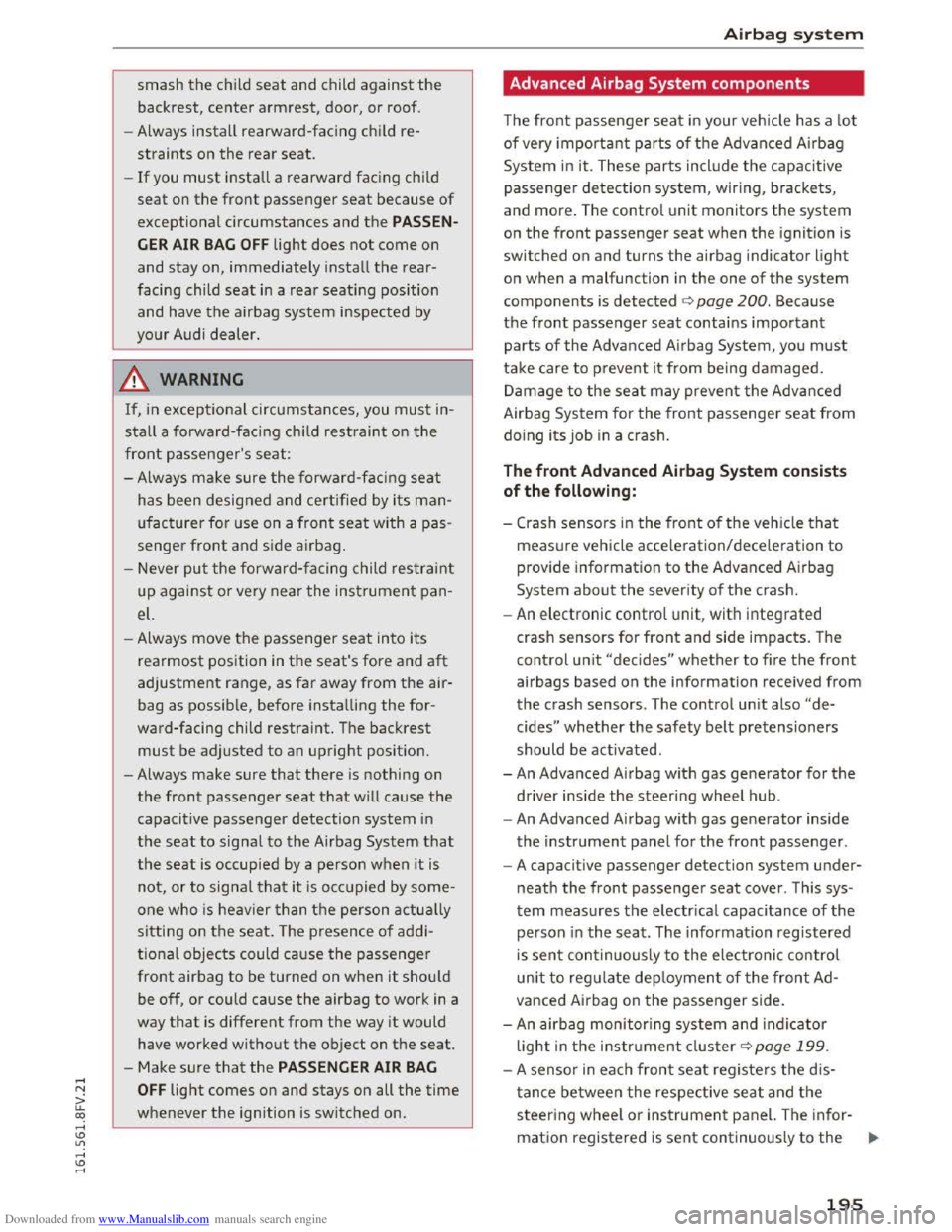
Downloaded from www.Manualslib.com manuals search engine smash the child seat and child against the
backrest, center armrest, door, or roof.
- Always
install rearward-facing child re
straints on the rear seat.
-If you must install a rearward facing child
seat on the front passenger seat because of
exceptional circumstances and the PASSEN
GER AIR BAG OFF light does not come on
and stay on, immediately install the rear
facing child
seat in a rear seating position
and have the airbag system inspected by
your Audi dealer.
A WARNING
If, in exceptional circumstances, you must in
stall a forward-fac ing chi ld restraint on the
front passenger's seat:
- Always make sure the forward-fac ing seat
has been designed and cer t ified by its man
ufacturer for use on a fron t seat with a pas
senger front and side airbag .
- Never
put the forward-facing child restraint
up against or very near the instrument pan
el.
-Always move the passenger seat into its
rearmost position in the seat's fore and aft
adjustment range, as far away from the air
bag as possible, before install ing the for
ward-facing child
restraint. The backrest
must be adjusted to an upright positio n.
-Always make sure that there is nothing on
the front passenger seat that will cause the
capacitive passenger detection system in
the seat to signa l to the Airbag System that
the seat is occupied by a person when it is
not, or to signa l that it is occupied by some
one who is heavier than the person actually
sitting on the seat. T he presence of addi
tional objec ts could cause the passenger
fro nt airbag to be turned on when it should
be off, or could cause the airbag to work in a
way
that is different from the way it would
have worked
without the object on the seat.
- Make
sure that the PASSENGER AIR BAG
OFF light comes on and stays on all the time
whenever the ignition is switched on.
Airbag system
Advanced Airbag System components
The front passenger seat in your vehicle has a lo t
of ve ry important parts of the Advan ced Airb ag
System in it. These parts include the capacitive
passenger detection system, wiring, brackets,
and more. The control unit monitors the system
on the front passenger seat when the ignition is
switched on and turns the airbag indicator light
on when a malfunction in the one of the system
components is detected c> page 200. Because
the front passenger seat contai ns important
parts of the Advanced Airbag System, you must
take care to p revent it from being damaged.
Dam age to the seat m ay prevent the Advan ced
Airbag
System for the front passenger seat from
doing its job in a crash.
The front Advanced Airbag System consists
of the following:
-Crash sensors in the front of the ve hicl e tha t
measure vehicle acceleration/deceleration to
prov ide information to the Advanced Airbag
System about the severity of the crash.
-
An electronic control unit, with integrated
crash sensors for front and side impacts. The
control un it "decides" whether to f ir e the front
airbags based on the information rece ived from
the crash sensors. The control unit also "de
cides" whether the safety belt pretensioners
should be activated.
-
An Advanced Airbag with gas generator for the
driver inside the steering wheel hub .
-
An Adva nced Airbag with gas generator inside
the instrument panel for the front passenger.
- A
capacitive passenger detection system under
neath the front passenger seat cove r. This sys
tem measures the electrica l capacitance of the
pe rson in the seat. The information registered
is sent continuous ly to the electronic control
u
nit to reg ulate deployment of t he front Ad
vanced Airbag on
the passenger side.
-
An airbag monitori ng system and ind ic a tor
ligh t in t he i nstrument cl us ter c>poge 199.
-A sensor in each front seat registers t he d is
tance between the respective seat and the
steering wheel or ins trument panel. The infor-
mation registered is sent continuousl y to the ...
195
Page 201 of 322

Downloaded from www.Manualslib.com manuals search engine those areas and yourself. These objects
could cause injury in a crash, especially
when the airbags inflate.
- Never recline
the front passenger's seat to
transport objects. Items can also move into
the area of the side airbag or the front air
bag during braking or in a sudden maneu
ver. Objects near the airbags can become
projectiles and cause injury, particularly
when the seat is reclined.
- Never place
or transport objects on the
front passenger seat. Objects on the front
passenger seat could cause the capac itive
sensor in the seat to signal to airbag system
that the seat is occup ied by a person when it
in fact is not, or that the person on the seat
is heavier than he or she actually is. The
change in electric capacitance because of
such objects can cause the passenger front
airbag to be turned on when it should be
off, or can cause the a irbag to work in a way
that is diffe rent from the way it would have
worked without objects on the seat.
- Always make sure that there is nothing on
the front passenger seat that will cause the
capaciti ve passenger detection system in
the seat to signal to the Airbag System tha t
the seat is occupied by a person when it is
not, or to signa l that it is occupied by some
one who is heavier than the person actually
sitting on
the seat. The presence of an ob
ject could cause the passenger front airbag
to be turned on when it should be off, or
cou ld cause the air bag to work in a way that
is different from the way it wou ld have
worked witho ut the object on the seat.
- Never tilt the front passenger seat backrest
forward when the vehicle is moving. An in
flating airbag will force the backrest back
ward and can injure rear seat occupants.
_&WARNING
The fine dust created when airbags deploy can
cause breathing problems for people w ith a
history
of asthma or other breathing condi
tions.
Airba g system
- To reduce the ris k of breathing problems,
those with asthma or other respiratory con
ditions should get fresh a ir right away by
getting out of the vehicle or opening win
dows or doors.
-
If you are i n a collision in which airbags de
p loy, wash your hands and face with mild
soap and water before eating.
-
Be carefu l not to get the dust into your eyes,
or into any cuts or scratches.
-Ifthe residue should get into your eyes,
f lush
them w ith water.
Monitoring the
Advanced Airbag System
t~~ Airbag monitoring indicator light
Two separate indicators monitor the function of
the Advanced Airbag System: the airbag moni
toring indicator light and the PASSENGER AIR
BAG OFF light.
The Advanced Airbag System as well as the side
airbags and side curta in airbags with ejection
mitigation features (including the electronic con
trol unit, sensors and system wiring) are all
monitored continuously to make sure that they
are functioning properly whenever the ignition is
on. Every time you turn on the ign ition, the a ir
bag system indica to r light II will come on for a
few
seconds ( function check).
The system must be inspected when the
indicator light II:
-does not come on when the ignition is sw itched
on,
-
does not go out a few seconds after you have
switched on the igni tion, or
-comes on while driving .
If an airbag system malfunction is detected, the
indicator light will first start flashing to catch the
driver's attention and then stay on continuously
to serve as a constant rem inder to have the sys
tem inspected immediately.
If a malfunction occurs that turns the front air-
bag on
the passenger side off, the PASSENGER ..,.
199
Page 204 of 322

Downloaded from www.Manualslib.com manuals search engine Airbag system
"
Important safety instructions on
monitoring the Advanced Airbag System
A WARNING
--I
-If the status of the Advanced Airbag System
has changed while the vehicle is moving, the
PASSENGER AIR BAG OFF light blinks for
about 5 seconds to catch the driver's atten
tion. If this happens, always stop as soon as
it is safe to do so and check the steps descri
bed above.
-If the PASSENGER AIR BAG OFF light does
not go off when an adult who is not very
small is sitti ng on the front passenger seat
after taking the steps described above,
make sure the adult is properly seated and
restrained at one of the rear seating posi
tions. Have the airbag system inspected by
your authorized Aud i dealer before trans
porting anyone on the front passenger seat.
A WARNING
An airbag system that is not functioning prop-
erly
cannot provide supplemental protection
in a frontal crash.
-
If the airbag indicator light Q page 15
comes when the vehicle is being used, have
the system inspected immediately by your
authorized Audi dealer. It is possib le that
the airbag will inflate when it is not sup
posed to, or will not inflate when it should.
A WARNING
If the front airbag inflates, a child without a
child
restrai nt, or in a rearward-facing child
safety seat, or in a forward-facing child re
straint that has not been properly installed
will be seriously injured and can be killed.
- Even
though your vehicle is equipped with
an Advanced Airbag System, make certain
that all children, especially 12 years and
younger, always ride on the back seat prop
erly
restrained for their age and size.
- Always install forward
or rear-facing child
seats on the rear seat -even with an Ad
vanced Airbag System.
202
-If you must install a rearward-facing child
seat on the front passenger seat because of
exceptional circumstances and the PASSEN
GER AIR BAG OFF light does not appear and
stay on, immediately install the rear-facing
child
seat in a rear seating position and have
the airbag system inspected by your Audi
dealer.
- If, in exceptional circumstances, you must
install a forward-facing child restraint on
the front passenger seat, always move the
seat into its rearmost position in the seat's
fore and aft adjustment range, as far away
from the airbag as possi ble. The backrest
must be adjusted to an upright position.
M
ake sure that the PASSENGER AIR BAG
OFF light comes on and stays on all the time
whenever the ignition is swi tched on.
A WARNING
---"
-If the PASSENGER AIR BAG OFF light does
not go out when an adult is sitting on the
front passenger seat after taking the steps
described above, make sure the adult is
properly seated and restrained at one of the
rear seating positions.
- Have
the airbag system inspected by your
Audi
dealer before transporting anyone on
the front passenger seat.
(1) Tips
If the capacitive passenger detection system
d etermines that the front passenger seat is
empty, the frontal airbag on the passenger
side will be turned off, and the PASSENGER
AIR BAG OFF light will stay on.
Repair, care and disposal of the airbags
Parts of the airbag system are installed at many
different places on your Audi. Installing, remov
ing, servicing
or repairing a part in an area of the
vehicle can damage a part of an airbag system
and prevent that system from working properly
in a collision.
There
are some important things you have to
know to make sure that the effectiveness of the ~
Page 205 of 322
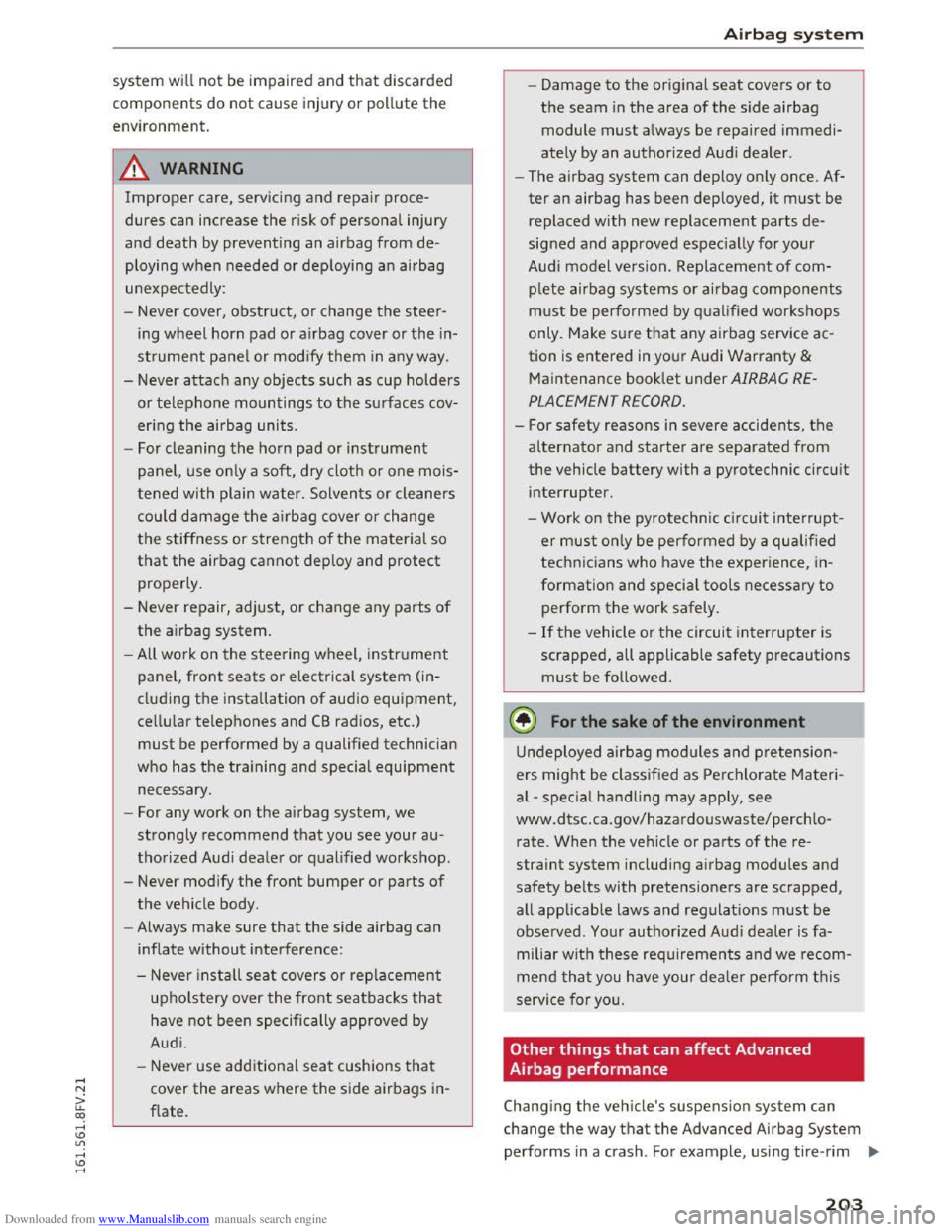
Downloaded from www.Manualslib.com manuals search engine system will not be impaired and that discarded
components do not cause injury or pollute the
environment.
A WARNING
Improper care, servicing and repair proce
dures can increase the risk of personal injury
and death by preventing an airbag from de
ploying when needed or deploying an airbag
unexpectedly:
- 1
-Never cover, obstruct, or change the steer
ing wheel horn pad or airbag cover or the in
strument panel or modify them in any way.
- Never
attach any objects such as cup holders
or telephone mountings to the surfaces cov
ering
the airbag units.
- For cleaning
the horn pad or instrument
panel, use only a soft, dry cloth or one mois
tened with plain water. Solvents or cleaners
could damage the airbag cover or change
the stiffness or strength of the material so
that the airbag cannot deploy and protect
properly.
- Never repair,
adjust, or change any parts of
the airbag system.
-All work on the steering wheel, instrument
panel, front seats or electrical system (in
cluding
the installation of audio equipment,
cellular telephones and CB radios, etc.)
must be performed by a qualified technician
who has the training and special equipment
necessary.
- For any work on
the airbag system, we
strongly recommend that you see your au
thorized Audi dealer or qualified workshop.
- Never modify
the front bumper or parts of
the vehicle body.
- Always
make sure that the side airbag can
inflate without interference:
- Never install
seat covers or replacement
upholstery over the front seatbacks that
have not been specifically approved by
Audi.
- Never
use additional seat cushions that
cover the areas where the side airbags in
flate.
Airbag system
-Damage to the original seat covers or to
the seam in the area of the side airbag
module must always be repaired immedi
ately by an authorized Audi dealer.
-The airbag system can deploy only once. Af
ter an airbag has been deployed, it must be
replaced with new replacement parts de
signed and approved especially for your
Audi
model version. Replacement of com
plete airbag systems or airbag components
must be performed by qualified workshops
only. Make sure that any airbag service ac
tion is
entered in your Audi Warranty &
Maintenance booklet under AIRBAG RE
PLACEMENT RECORD.
-For safety reasons in severe accidents, the
alternator and starter are separated from
the vehicle battery with a pyrotechnic circuit
interrupter.
-Work on the pyrotechnic circuit interrupt
er must only be performed by a qualified
technicians who have
the experience, in
formation and special tools necessary to
perform the work safely.
-
If the vehicle or the circuit interrupter is
scrapped, all applicable safety precautions
must be followed.
@ For the sake of the environment
Undeployed airbag modules and pretension
ers might be classified as Perchlorate Materi
al -special handling may apply, see
www.dtsc.ca.gov/hazardouswaste/perchlo
rate. When the vehicle or parts of the re
straint system including airbag modules and
safety belts with pretensioners are scrapped,
all applicable laws and regulations must be
observed. Your authorized Audi dealer is fa
miliar
with these requirements and we recom
mend that you have your dealer perform this
service for you.
Other things that can affect Advanced
Airbag performance
Changing the vehicle's suspension system can
change the way that the Advanced Airbag System
performs in a crash. For example, using tire-rim ..,.
203
Page 208 of 322
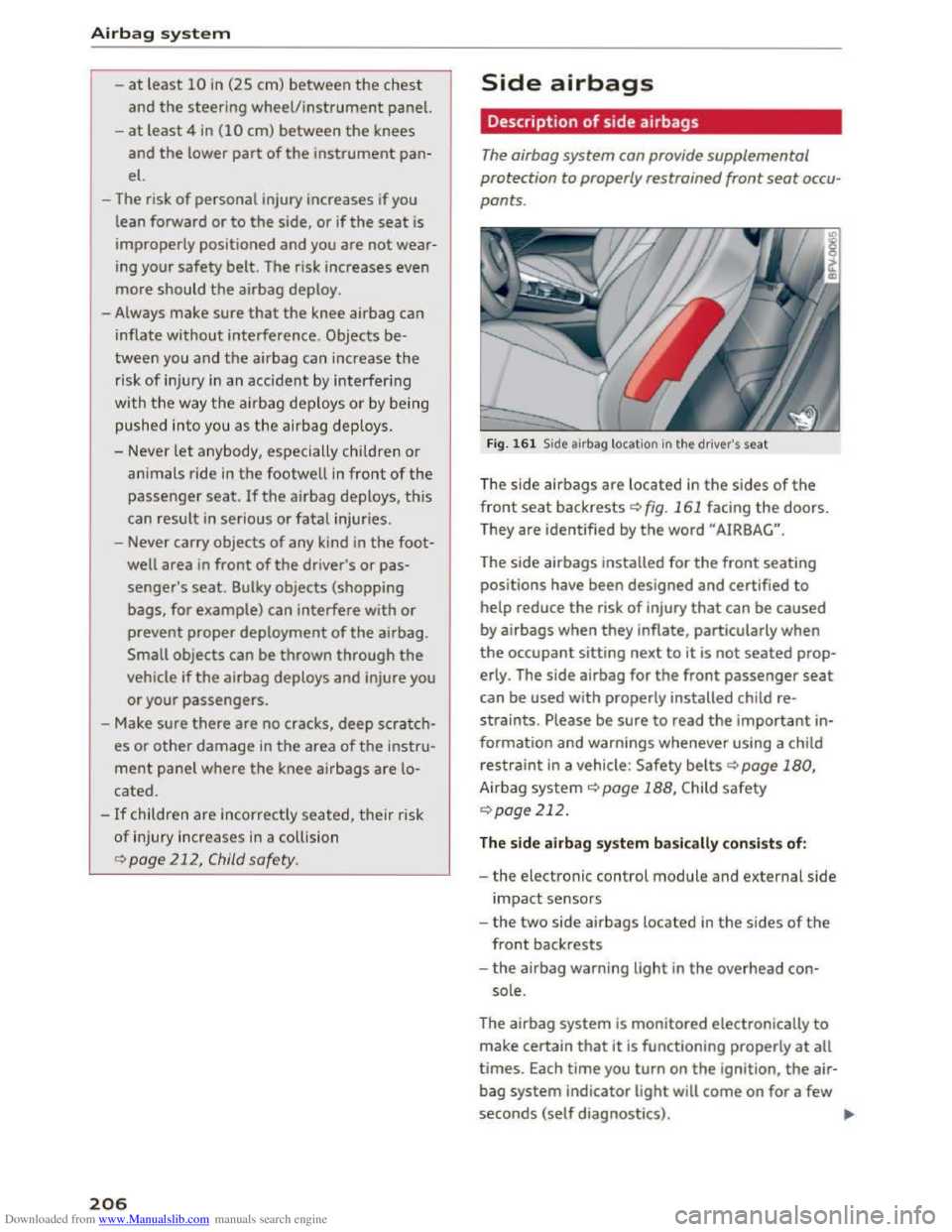
Downloaded from www.Manualslib.com manuals search engine Airbag system
-at least 10 in (25 cm) between the chest
and the steering wheel/instrument panel.
-
at least 4 in (10 cm) between the knees
and the lower part of the instrument pan
el.
- The risk
of personal injury increases if you
lean forward
or to the side, or if the seat is
improperly positioned and you are not wear
ing your safety belt. The risk increases even
more should the airbag deploy.
- Always
make sure that the knee airbag can
inflate without interference. Objects be
tween you and the airbag can increase the
risk of injury in an accident by interfering
with
the way the airbag deploys or by being
pushed into you as the airbag deploys.
- Never
let anybody, especially children or
animals ride in the footwell in front of the
passenger seat. If the airbag deploys, this
can result in serious or fatal injuries.
- Never carry
objects of any kind in the foot
well area in front of the driver's or pas
senger's seat. Bulky objects (shopping
bags, for example) can interfere with or
prevent proper deployment of the airbag.
Small objects can be thrown through the
vehicle if the airbag deploys and injure you
or your passengers.
-Make sure there are no cracks, deep scratch
es or other damage in the area of the instru
ment panel where the knee airbags are lo
cated.
-If children are incorrectly seated, their risk
of injury increases in a collision
~page 212, Child safety.
206
Side airbags
Description of side airbags
The airbag system can provide supplemental
protection to properly restrained front
seat occu
pants .
Fig . 161 Side airbag location in the driver's seat
The side airbags are located in the sides of the
front seat backrests Q fig. 161 facing the doors.
They
are identified by the word "AIRBAG".
The side airbags installed for the front seating
positions have been designed and certified to
help reduce the risk of injury that can be caused
by airbags when they inflate, particularly when
the occupant sitting next to it is not seated prop
erly. The
side airbag for the front passenger seat
can be used with properly installed child re
straints. Please be sure to read the important in
formation and warnings whenever using a child
restraint in a vehicle: Safety belts Q page 180,
Airbag system Q page 188, Child safety
¢page 212.
The side airbag syste m b asica lly consist s o f:
-
the electronic control module and external side
impact sensors
-the two side airbags Located in the sides of the
front backrests
-the airbag warning light in the overhead con
sole.
The airbag system is monitored electronically to
make certain that it is functioning properly at all
times. Each time you turn on the ignition, the air
bag system indicator light will come on for a few
seconds (self diagnostics). Iii>
Page 210 of 322
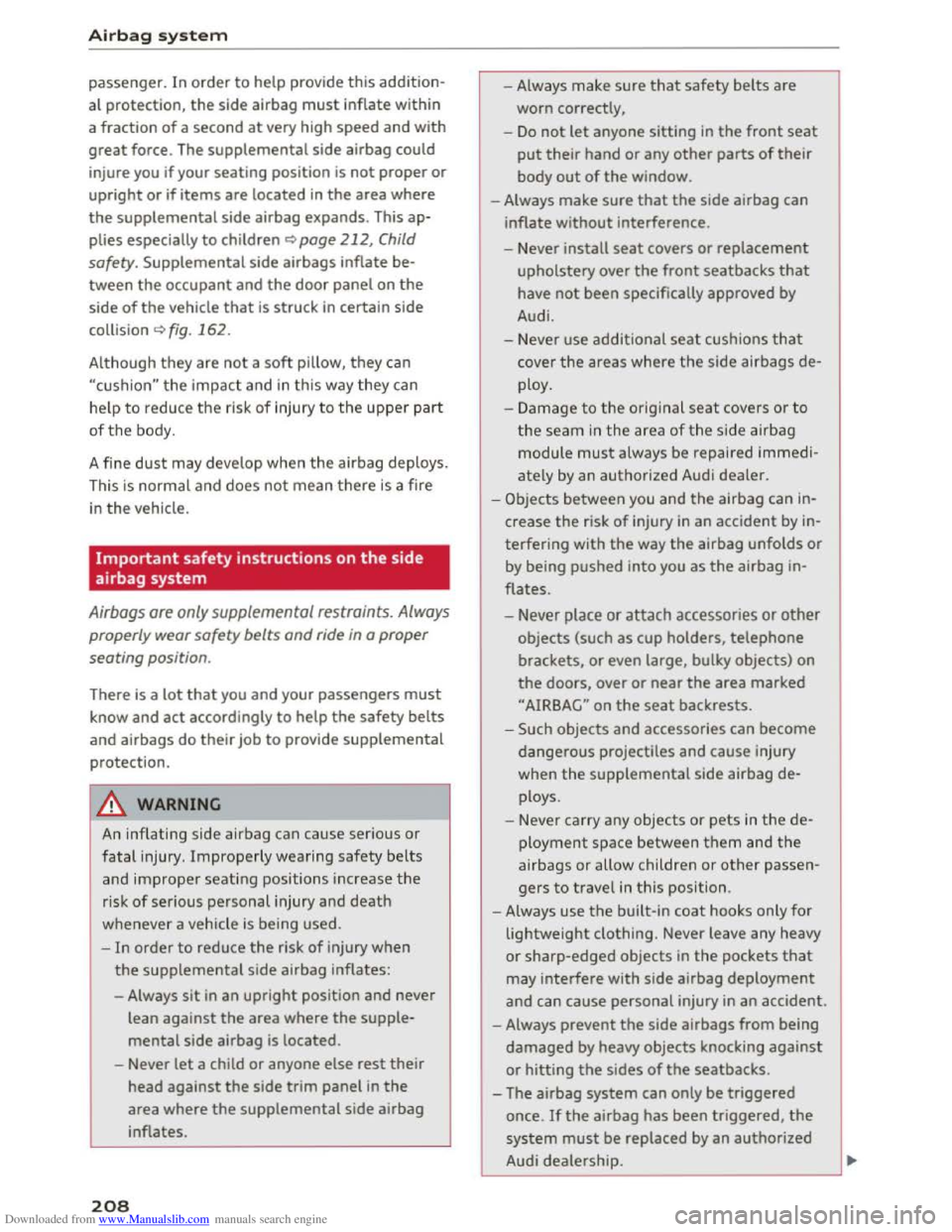
Downloaded from www.Manualslib.com manuals search engine Airbag sy ste m
passenger. In order to help provide this addition
al protection, the side airbag must inflate within
a
fraction of a second at very high speed and with
great force . The supplemental side airbag could
injure you if
your seating position is not proper or
upright or if items are located in the area where
the supplemental side airbag expands. This ap
plies especially to children Q page 212, Child
safety.
Supplemental side airbags inflate be
tween the occupant and the door panel on the
side of the vehicle that is struck in certain side
collision Qfig. 162.
Although they are not a soft pillow, they can
"cushion" the impact and in this way they can
he lp
to reduce the risk of injury to the upper part
of the body.
A fine
dust may develop when the airbag deploys.
This is
normal and does not mean there is a fire
in the vehicle.
Important safety instructions on the side
airbag
system
Airbags ore only supplemental restraints. Always
properly wear safety belts and ride in a proper
seating posit ion.
There is a lot that you and your passengers must
know and act accordingly to help the safety belts
and airbags do their job to provide supplemental
protection.
A WARNING
An inflating side airbag can cause serious or
fatal injury. Improperly wearing safety belts
and improper seating positions increase the
r isk of serious personal injury and death
whenever a vehicle is being used.
-In order to reduce the risk of injury when
the supplemental side airbag inflates:
-Always sit in an upright position and never
lean against the area where the supple-
mental side airbag is located.
-Never let a child or anyone else rest their
head against the side trim panel in the
area where the supplemental side airbag
inflates.
208
-Always make sure that safety belts are
worn correctly,
-
Do not let anyone sitting in the front seat
put their hand or any other parts of their
body out of the window.
- Always
make sure that the side airbag can
inflate without interference.
- Never install seat covers or replacement
upholstery over the front seatbacks that
have not been specifically approved by
Audi.
- Never
use additional seat cushions that
cover the areas where the side airbags de
ploy.
-
Damage to the original seat covers or to
the seam in the area of the s ide airbag
module must always be repaired immedi
ately by an
authorized Audi dealer.
-Objects between you and the airbag can in
crease the risk of injury in an accident by in
terfering with the way the airbag unfolds or
by being pushed into you as the airbag in
flates.
-Never place or attach accessories or other
objects (such as cup holders, telephone
brackets, or even large, bulky objects) on
the doors, over or near the area marked
"AIRBAG" on the seat backrests.
-Such objects and accessories can become
dangerous projectiles and cause injury
when the supplemental side airbag de
ploys.
- Never carry any
objects or pets in the de
ployment space between them and the
airbags or allow children or other passen
gers to travel in this position.
- Always
use the built-in coat hooks only for
lightweight clothing. Never leave any heavy
or sharp-edged objects in the pockets that
may interfere with side airbag deployment
and can cause personal injury in an accident.
- Always
prevent the side airbags from being
damaged by heavy objects knocking against
or hitting the sides of the seatbacks.
-The airbag system can only be triggered
once. If the airbag has been triggered, the
system must be replaced by an authorized
Audi dealership. ~
Page 212 of 322
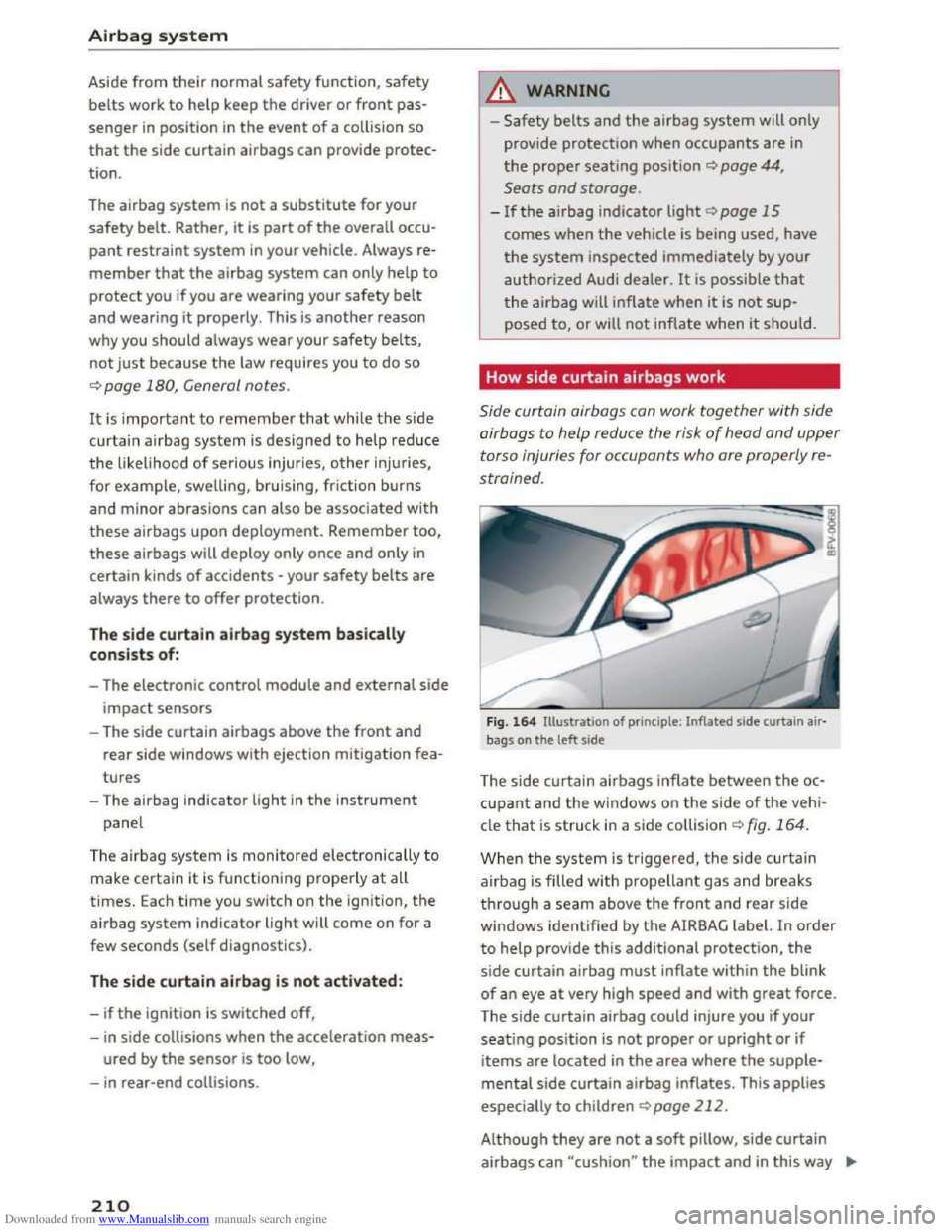
Downloaded from www.Manualslib.com manuals search engine Airbag sy stem
Aside from their normal safety function, safety
belts work to help keep the driver or front pas
senger in position in the event of a collision so
that the side curtain airbags can provide protec
tion .
The airbag
system is not a substitute for your
safety belt. Rather, it is part of the overall occu
pant restraint system in your vehicle. Always re
member that the airbag system can only help to
protect you if you are wearing your safety belt
and wearing it properly . This is another reason
why you
should always wear your safety belts,
not just because the law requires you to do so
~page 180, General notes.
It is important to remember that while the side
curtain a irbag system is designed to help reduce
the likelihood of serious injuries, other injuries,
for
example, swelling, bruising, friction burns
and minor abrasions can also be associated with
these airbags upon deployment. Remember too,
these airbags will deploy only once and only in
certain kinds of accidents -your safety belts are
always there to offer protection.
The side curta in airbag sy stem basically
consists
of:
-The electronic control module and external side
impact sensors
-The side curtain airbags above the front and
rear side windows with ejection mitigation fea
tures
-The airbag indicator light in the instrument
panel
The airbag system is monitored electronically to
make certain it is function ing properly at all
times. Each time you switch on the ignition, the
airbag system indicator light will come on for a
few seconds (self diag nasties).
The side curtain airbag is not activated:
-if the ignition is switched off,
-
in side collisions when the acceleration meas-
ured by the sensor is too low,
- in
rear-end collisions .
210
A WARNING
-Safety belts and the airbag system will only
provide
protection when occupants are in
the proper seating position Q page 44,
Seats and storage.
-If the airbag indicator light Q page 15
comes when the vehicle is being used, have
the system inspected immediately by your
authorized Audi dealer. It is possible that
the airbag will inflate when it is not sup
posed to, or will not inflate when it should.
How side curtain airbags work
Side curtain airbags can work together with side
airbags to help reduce
the risk of head and upper
t orso injuries for occupants who are properly re
strained.
Fig. 164 Illustration of principle: Inflated side curtain air
bags on
the left side
The side curtain airbags inflate between the oc
cupant and the windows on the side of the vehi
cle
that is struck in a side collision Q fig. 164.
When the system is triggered, the s ide curtai n
airbag
is filled with propellant gas and breaks
th rough a seam above the front and rear side
windows identified by the AIRBAG label. In order
to help provide this additional protection, the
side curtain airbag must inflate within the blink
of an eye at very high speed and with great force .
The
side curtain airbag could injure you if your
seating position is not proper or upright or if
items are located in the area where the supple
mental side curtain airbag inflates. This applies
especially to children Qpage 212.
Although they are not a soft pillow, side curtain
airbags can "cushion" the impact and in this way .,..